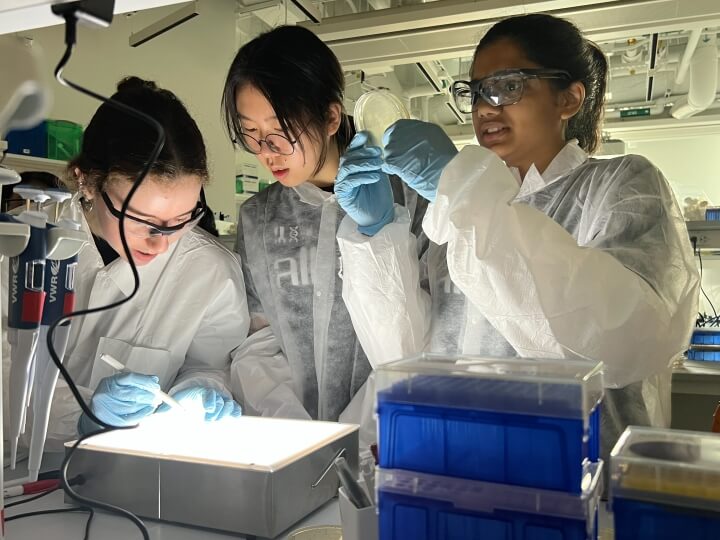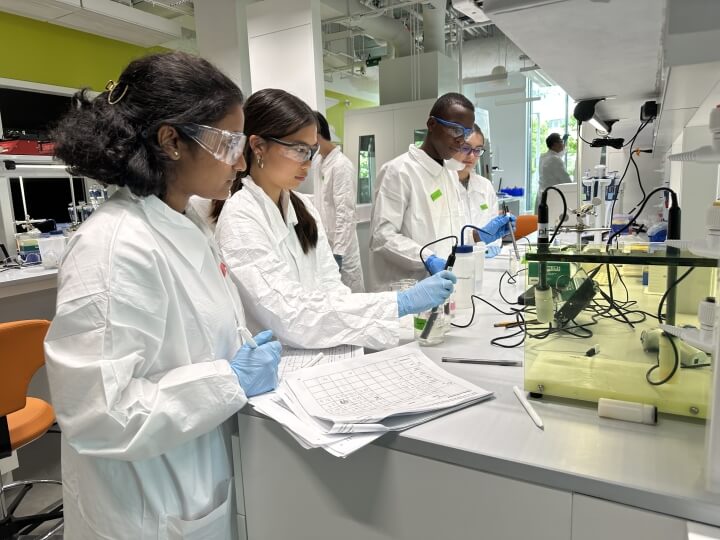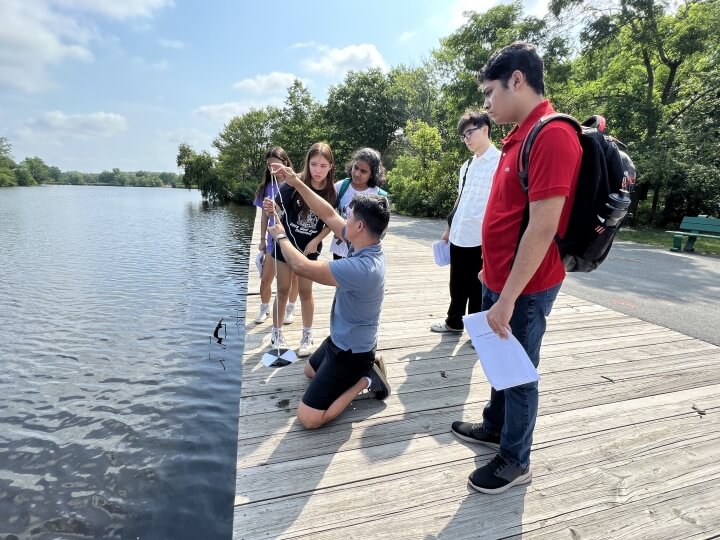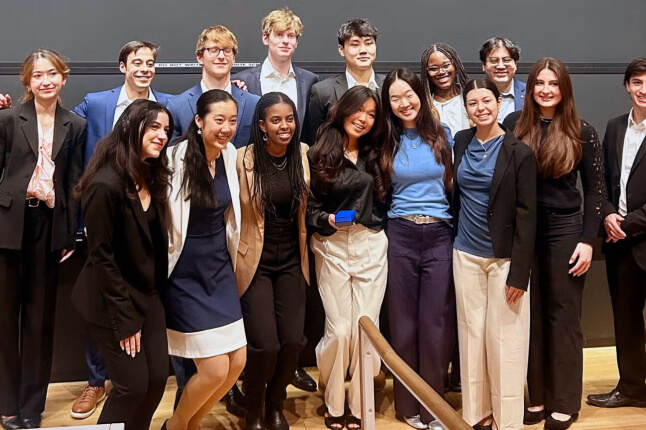News
Mikhal Shvartsman (Lincoln-Sudbury High School), Emily Kuang (Lexington High School), and Aditi Rajvanshi (Lexington High School) assess the results of their CRISPR/Ca9 gene editing experiment. (Avery Normandin/Active Learning Labs)
It was hands-on, lab-based research for 23 high school students who tackled such complex topics as new cancer therapies and emerging issues in water quality.
With the goal of inspiring students who may not be aware of opportunities in science and engineering, the Active Learning Labs (ALL) at the Harvard John A. Paulson School of Engineering and Applied Sciences hosted two outreach programs for local and international teens in July.
Developed and directed by ALL’s Melissa Hancock, Avery Normandin, and Nicholas LoRusso, the programs were designed to be as accessible to students as possible.
“Our goal … is to open up Harvard’s resources and expertise to the broader community,” said Normandin. “We want to give students from local high schools and beyond tangible, meaningful experiences in biological and environmental engineering.”
In the first weeklong program, Bioengineering Science, Technology and Research (BioSTAR), 12 students from the Boston area learned how to culture breast cancer cells as 3D spheroids and synthesize drug nanoparticles that were used to treat the cancer cells.
“What excited me the most was creating nanoparticles for drug delivery application,” said Mikhal Shvartsman, a junior from Lincoln-Sudbury Regional High School. “It was incredible to see how drug delivery can be manipulated and incredible to learn about how you can use [the particles] for targeted drug delivery.”
In addition to experimentations at the lab bench, students learned more about the current state of cancer therapy research through informal discussions with Samir Mitragotri, a Wyss Institute core faculty member and faculty sponsor for BioSTAR, and the bioengineering graduate students and postdoctoral fellows who helped teach lab techniques.
Students also learned about gene-editing techniques and used CRISPR-Cas9 to deactivate gene expression in E. coli.
“This program provides students interested in pursuing bioengineering, or a similar field, with experience that prepares them for real lab work,” said Arlington High School student Isobel Maksoudian.
Participants in the 2023 EnviroSTAR program assess local water quality in the Environmental Engineering Active Learning Lab at SEAS
“What astounded me about the BioSTAR program was the quality of instruction we received and the experiments we performed,” she continued. “Everyone came into the program with different backgrounds and skill levels, but we all left with the same foundational skills and knowledge.”
“Getting to work directly with materials that are used by undergraduates and graduates alike in Harvard University’s labs led me to a greater understanding of what the field of biomedical engineering is actually like,” said Amrit Chadha from Arlington High School.
The success of BioSTAR, which has completed its fourth iteration, led to the development of Environmental Science, Technology and Research (EnviroSTAR), which introduces high school students to global environmental challenges.
Eleven students from regions spanning Canada, China, Kenya, and the U.S. participated in the program and got a peek at life as an environmental engineer. Kelvin Ndolo from Clay International Secondary School in Kiangini, Kenya, appreciated how the program “brings different participants [from] all over the world and people are able to give different ideas.”
Centered around water engineering and the ways communities access clean water, the fast-paced curriculum had students taking quality measurements of local water samples using various instrumentation in the lab. In addition to chemical measurements, students performed experiments to assess contaminants ranging from microbes to microplastics.
Arlington High School junior Elena Wisniewski said she most enjoyed “learning about the chemistry behind water using probes and what properties can make our water dangerous, such as microbes and microplastics.”
Lessons inside the lab were reinforced by a short walk to the banks of the Charles River, where LoRusso and Bryan Yoon, assistant director of undergraduate studies in environmental science and engineering, taught students how to perform field work and sample collection. Students also got a behind-closed-doors tour of the Fresh Pond Walter J. Sullivan Water Treatment Facility in Cambridge.
Both stops left an impression on Mrigank Dhingra. “Taking field trips to the Charles River and the Fresh Pond Water Treatment Facility excited me the most because I got to experience a real-world challenge and how people were using principles of environmental engineering to protect and filter water,” Dhingra said.
Nishka Avunoori from Chester Brook, Pennsylvania, said, “EnviroSTAR helped me apply my knowledge in both the lab and the field and showed me how important collaboration is in this area of science. [The program] helped me understand the beauty of our environment and showed me that this field is constantly evolving and requires creativity, innovation, and a strong commitment to our environment.”
Bryan Yoon demonstrates the use of a Secchi disk to assess water turbidity along the banks of the Charles River. (Avery Normandin)
On the last two days of the program, students shifted focus to design engineering and worked in small teams to design, build, and test water-filter systems. Through discussions with Anas Chalah, assistant dean for teaching and learning, and David Sekoll from ALL, students learned about factors that inform design decisions and the importance of building and testing small-scale prototypes.
Guest speakers from the Harvard community also met with the students to discuss their current research and inventions for removing impurities from water. When the student teams began building filters in the REEF Makerspace (Reimagining Experiential Education and Fabrication), each came up with a different approach to filtering water.
“I definitely learned a lot about the design process and how much experimentation it takes,” said Soleil Hayes-Pollard from Brookline High School. “I also got a better understanding of taking a design and creating a physical prototype and learned about how many changes you may need to make and how different it can end up from your original design.”
“It was definitely satisfying to do things with my own hands, and I will say that I am proud of the work that I’ve done,” said Emily Kuang from Lexington High School.
Topics: Academics, Active Learning Labs, Bioengineering, Environment, Environmental Science & Engineering
Cutting-edge science delivered direct to your inbox.
Join the Harvard SEAS mailing list.





